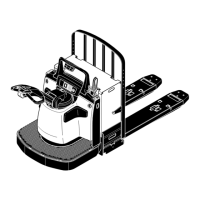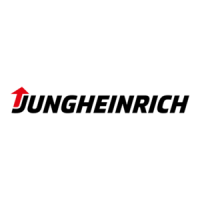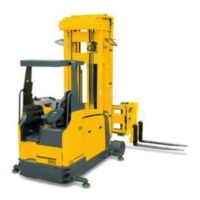0705.USA
E 18
Repairs:The driver must not repair or modify the industrial truck unless he or she has
received special training and has obtained express approval to do so. Under no
circumstances must the driver change the setting of switches or safety systems or
disable them.
3.3 Aspects in relation to loading
Sensors: If a load extends beyond the width and/or length of the industrial truck, the
owner should ask for sensors to be used in the direction of travel, which cover the
maximum width and/or length of the industrial truck, to prevent the load from coming
into contact with an obstacle.
Stability: Industrial trucks complying with the requirements set out in ASME B56.1-
2003 are stable when used correctly. Any unstable state can be attributed to improper
use, poor maintenance, travel ways and working areas.
The truck's stability can be adversely affected by the following factors, for example:
ground conditions (such as ice, oil, or water), slopes, speed, load behavior (even
when unladen, industrial trucks with attachments can behave like partly laden trucks),
battery weight, dynamic and static forces, and the judgment of the operator.
Use batteries whose weight is within the minimum and maximum range as stated on
the truck's nameplate (see "Nameplate, vehicle" in Chapter D).
The user is responsible for ensuring that the load is stable and secure. This should
be checked where necessary.
The owner must take note of special operating conditions. The stability of an industrial
truck as determined by intensive tests laid down in ASME B56.1-2003 in accordance
with the manufacturer's requirements does not take account of situations where an
industrial truck is operated on a slope or with a load that is far outside the center of
gravity.
Some users may have established stability requirements for general applications
which differ from the manufacturer's requirements in accordance with ASME B56.1-
2003. The user, in cooperation with the manufacturer, must, however, use the
regulations laid down in ASME B56.1-2003 Section 7.6 as a basis for his or her own
more stringent requirements. Changes are permitted only with the manufacturer's
prior, written approval of the proposed changes or additions.
Extending the safety guard: If the nature of the load presents a danger, the owner
should fit a vertical extension to the truck's safety guard, manufactured in accordance
with the manufacturer's requirements as set out in ASME B56.1-2003.

